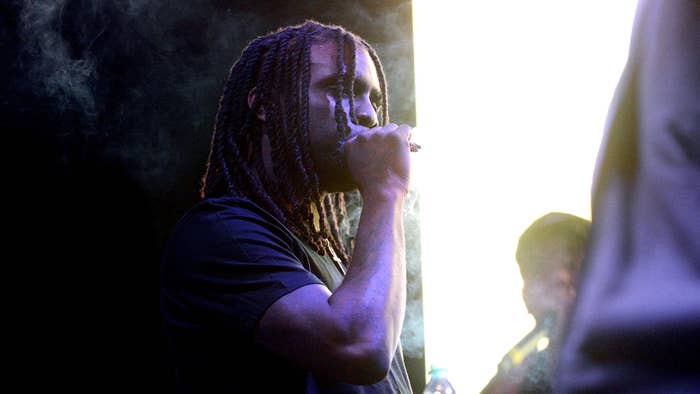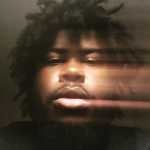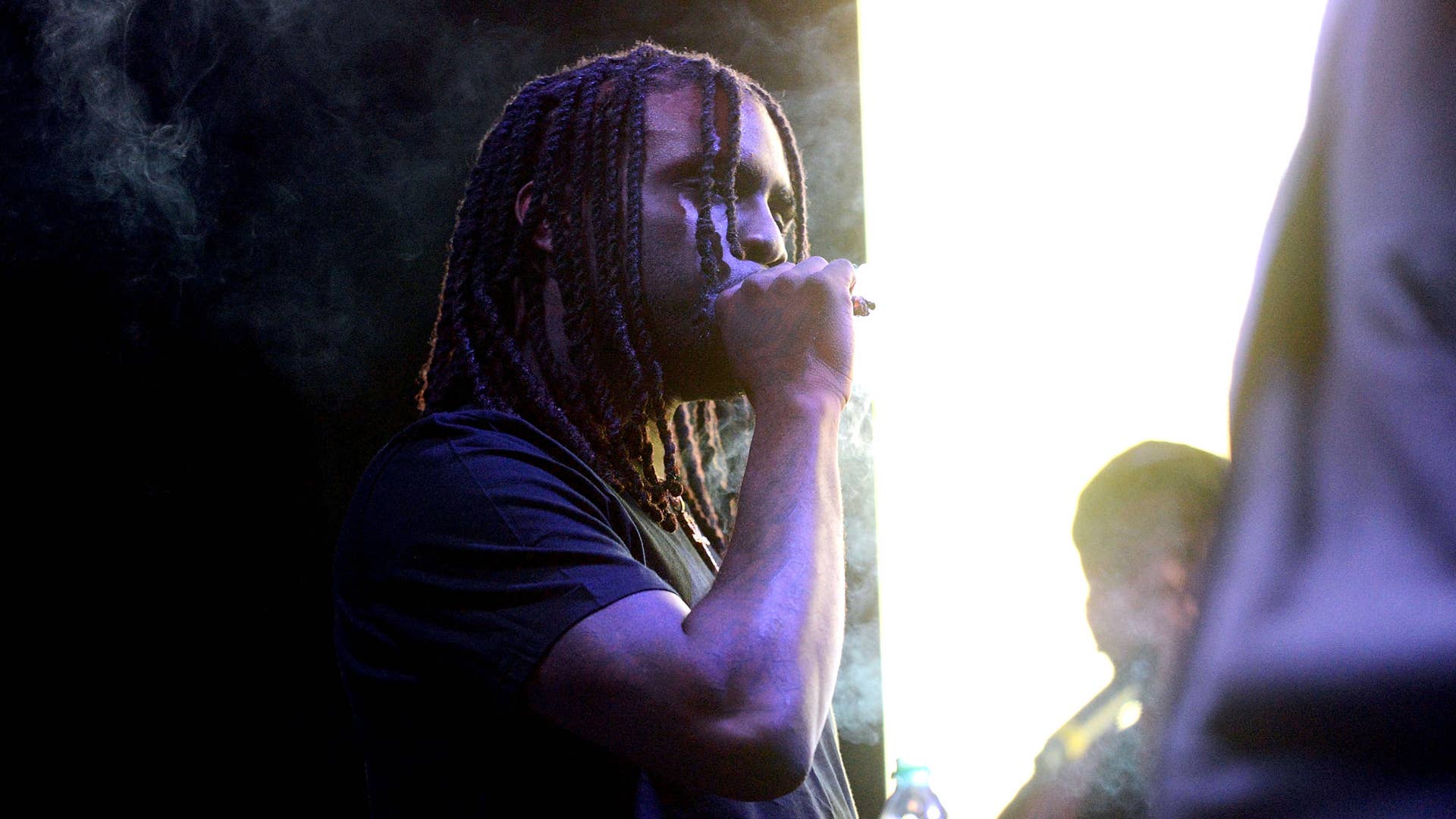
In which of the following scenarios is Chief Keef a bigger legend? One where he’s a pioneer of a Chicago drill scene full of artists who survived, stayed free, and coexisted enough to become a multi-platinum music scene, ala Atlanta trap? Or the current reality, where many drill artists have died or went to prison, and his presence isn’t just a testament to his musical ability but to his resolve? It’s a debatable topic, but either way you look at it, Chief Keef is an icon.
There are fans who view him as a cautionary tale of immaturity and unfulfilled potential. But the question then would be fulfillment for who? Chief Keef turns 25 today, and he’s done about everything he wanted to do, no matter who didn’t want him to do it. He’s a legend, not just because he helped introduce drill music to the world and became a pillar of a city that rewrote the cultural lexicon, but because he beat the music industry at their own game.
Chief Keef, born Keith Farrelle Cozart, was a 16-year-old on house arrest when he first reached national notoriety. A chance encounter with the Chicago Police Department turned into four felonies after the cops alleged that he aimed a gun at them and ran away. Considering the plight of Black people at the hands of cops, it’s a minor miracle that he left that situation alive. He received 30 days of house arrest and 30 days of home confinement for the charges, which included unlawful use of a gun.
In a peculiar twist of fate, a viral video of a fan celebrating his release from house arrest roused people to look him up online. Curious scavengers found Bang and the video for the title track, which soon amassed millions of views. Bang was undoubtedly inspired by Gucci Mane and Waka Flocka’s output, but instead of replicating Gucci’s dexterous twang or Flocka’s brute force, Keef commandeered the menacing production with a steely, at times melodic delivery. Chicago had long been known for Kanye West and Common on one spectrum, and Do or Die and Twista on the other, but something new was happening. Keef was a burgeoning master of drill music, a churning cousin of trap born from Chicago’s gang epidemic.
People all over the country were taking notice of what was happening in Chicago by early 2012, and Chief Keef was feeding them by uploading his videos straight to YouTube. Fans were hooked by the time he dropped his ode to disdain, “I Don’t Like.” Little did the industry know, he was foreshadowing the rest of his career. Keef became one of the rap world’s hottest acts that year, spurred by his Back From The Dead mixtape and Kanye’s star-studded “I Don’t Like” remix. There were a slew of artists trying to sign him, including Soulja Boy’s SODMG, Birdman’s Cash Money, and Young Jeezy’s CTE. He ultimately inked a deal with Interscope, marking a new career plateau. But it was soon evident that he wasn’t down for the industry game.
During a January 2013 interview with Richmond’s Power 92.1, radio jock TT Torrez asked Keef if he viewed 50 Cent, who he had begun hanging out with, as a mentor. Most PR-trained artists would’ve given a fluff, make-nice answer, but Keef gave them the truth: “Nah, we be riding Ferrari's together. He's cool, but I don't know who told you that stuff right there." He also clarified why he didn’t sign to Young Jeezy’s CTE: “I can sign people, why would I sign to Young Jeezy?”
He wasn’t even 20 years old yet, but it was clear that he was already his own man. As he reflected in 2015, disenchantment permeated his Interscope experience, especially after former Interscope CEO Jimmy Iovine’s departure for Apple in 2014. Keef no-showed performances, skipped label obligations, and infamously left 50 Cent and Wiz Khalifa in the desert when he ditched his own “Hate Being Sober” video shoot. 50 later tweeted, "It’s not funny @ChiefKeef didn't sell any records yet, they will pull the plug on him.” Little did 50 know, Keef couldn’t have cared less. Young Chop has said that he felt like Interscope executives “didn’t understand” Chief Keef. But even if they didn’t understand him, he understood the game.
In a span of just months, Keef had gone from a kid just scraping by on the block to a burgeoning superstar. His rapid ascent exhibited all the ways in which stardom can be dehumanizing. Most artists with a modicum of talent get thrust into an industry fishbowl where that ability gets relentlessly commodified. People see them as everything but a person. Labels saw Keef as a product. Voyeuristic fans belittled him into a veritable comic book character in a Chicago gang epidemic they vicariously spectated online. Critics like Rhymefest thought he was a “bomb” who “represents the senseless savagery that white people see when the news speaks of Chicago violence.” Then-Chicago mayor Rahm Emanuel made drill artists the scapegoats for gun violence instead of championing them for finding a creative outlet in spite of all the ways the city failed them. So many people had defined Chief Keef before he was able to define himself. It shouldn’t come as a surprise that he quickly wanted out, and he deserves credit for forcing his way out of the label.
Some of his antics were immature, sure. But it felt good to see a label get screwed over for once. The music industry subsists on signing young Black artists to exploitative deals. Chief Keef could have been just another name on the conveyor belt, tossed on the shelf once the relationship was no longer beneficial. But Keef got fame, finances for his next moves, and left them behind to go independent. In January 2014, over two years after his Finally Rich debut, he was formally released from Interscope.
Chief Keef should be championed for who he is today: self-assured in an era when everyone else is chasing fleeting validation.
Chief Keef could have been the first artist to sign with Apple Music in 2014, but he turned it down. “I don’t know. I just didn't do it,” he told XXL. Apple Music head of content Larry Jackson has said that he didn’t expect Keef to accept the deal, implying an instinctual understanding of the rapper’s maverick streak.
By Spring 2014, Keef had left Chicago for L.A. He couldn’t do shows in Chicago and had to be wary of how he moved in the city because of rival gangs. He had relegated himself to Chicago’s affluent Highland Park neighborhood, and even still, neighbors complained until he was evicted. Despite his newfound fame, and lack of violent activity since attracting that fame, Chicago’s establishment never embraced him. In the summer of 2014, he received two Cook County bench warrants for failed court appearances. Even if he ever wants to come back from L.A., he can’t do so without risking arrest.
Once again, the legal system was the harbinger for a new chapter for Chief Keef. In L.A., he was no longer facing expectations of music stardom by labels and fans, or being demonized as the Chicago reaper. In 2015, the then-20-year-old told Billboard that, "It's better out here [in L.A.] than in Chicago, because I got in so much trouble. I like living out here. I think it improved me. It changed me, and [inspired] me to go somewhere bigger."
He also noted during that interview that the 2014 murder of his cousin, Big Glo, let him know it was time to “grow up.” With death so prevalent around him, perhaps he theorized a silver lining out of self-preservation. Tragically, just a day after the listening session where he spoke to Billboard, his friend, rapper Capo, was shot and killed in Chicago. In January of 2018, his cousin, beloved rapper Fredo Santana, had a fatal seizure at 27. In June, original Glo Gang member Tray Savage was killed in Chicago. During an episode of The Therapist, he counted over 11 people who were killed. When Dr. Siri Sat Nam Singh asked him if it was “emotionally unhealthy” to not feel sadness over their loss, Keef shrugged and said, “I don’t know.”
His career is a case study in reevaluating how we perceive music industry success, especially for Black artists. Is it about metrics or an artist’s sense of fulfillment?
You can scroll the comments of old Keef videos and see people bemoaning how many of the young men in the clips are dead. He was shot at in June of 2018 on orders of 6ix9ine, who he had an online war of words with. It wouldn’t be surprising if trauma is weighing on him in a manner that he can’t articulate; perhaps there are no words for such incalculable loss. But one word that can be used to accurately describe him is perseverance.
He’s channeled Gucci Mane by releasing dozens of projects over the past five years, all independently. Though he largely steers clear of mainstream rap, he occasionally appears on major label projects, most recently collaborating with Lil Uzi Vert on “Kobe (Bean)” from Eternal Atake.
Uzi has often commended Sosa for having an influence on his sound, and he’s not the only young artist to celebrate Keef’s impact. Lil Pump told J. Cole that Keef’s arrival felt like a “whole new era” for hip-hop. Uzi and Playboi Carti have both marveled at how Chief Keef’s initial impact was so immense that XXL put him on their 2012 Freshman cover despite him not being present for the shoot (he was serving a 6-day jail sentence).
Keef first achieved acclaim with gritty, no-nonsense records, but Finally Rich harbors a melody-driven sound that serves as the framework for so much neoteric trap rap. “Love Sosa,” “No Tomorrow,” and “Citgo” are in the musical DNA of your favorite rap crooner, from Uzi to Lil Baby to Post Malone. And once that sound got old to him, he unveiled a new one.
Projects like Almighty So and Back From The Dead 2 demonstrate a muttering, warbly mic presence that’s become the basis for the sound pejoratively called “mumble rap.” His “squad,” gang,” and “aye” ad-libs are everywhere now. Keef doesn’t simply record his ad-libs after the verse, as is custom. His free-flowing style allowed him to fuse his sloganeering into the actual verse in a manner that many artists ran with. He has the musical range to go from “Faneto” to “Can You Be My Friend,” a breezy Dancehall-flavored song.
Chief Keef doesn’t have a boatload of plaques or trophies, and he’ll have to be unbanned from the BET awards to receive a lifetime achievement nod, but he deserves all his flowers now. His impact on rap, and popular culture in general, is undeniable. He was one of the first artists to blow up on YouTube. He had a hand in the formation of two rap subgenres that are now worldwide. If he wanted to play the industry game, he’d have every accolade there is. But he doesn’t care to.
Having such a big impact on mainstream rap, while simultaneously spurning the machine, is nothing short of legendary. Instead of lamenting what could have been, Chief Keef should be championed for who he is today: self-assured in an era when everyone else is chasing fleeting validation. His career is a case study in reevaluating how we perceive music industry success, especially for Black artists. Is it about metrics or an artist’s sense of fulfillment?
He left the majors, refusing to be exploited for his talent, and is better off operating on his own terms. There may have been other brilliantly talented artists lost to the streets who could have similarly influenced pop culture, but they didn’t get a chance to tell their story. Chief Keef’s impact speaks for all of their potential.





